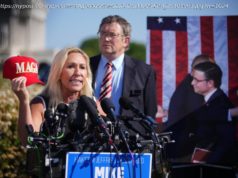After the longest tenure in agency history without a permanent leader, the U. S. Senate confirmed President Donald Trump’s pick to lead NASA on Thursday, April 19 in Jim Bridenstine.
After the longest tenure in agency history without a permanent leader, the U. S. Senate confirmed President Donald Trump’s pick to lead NASA on Thursday, April 19 in Jim Bridenstine.
Bridenstine is a Republican Oklahoma congressman, and was originally nominated to lead the U. S. space agency nearly eight months ago. The position opened when Charles Bolden Jr. stepped down on the first day of Trump’s presidency, and has been filled by longtime NASA official Robert Lightfoot Jr.
The New York Times reports Bridenstine was confirmed with a 50-49 party-line vote on Thursday. This makes him the first elected official to be confirmed to serve as NASA administrator. His nomination was opposed by many due to the fact that he was a politician, and a partisan one at that.
One of the main critics of his confirmation was Sen. Bill Nelson, D-Florida, who said that Bridenstine was too political to run the space agency.
«I think what’s not right for NASA, is an administrator who is politically divisive and who is not prepared to be that last in line to make that fateful decision on ‘go’ or ‘no-go’ for launch,» the Times reports Nelson said during a speech on Wednesday.
The NASA administrator a scientist or official with the space agency who is not such a partisan figure, as the agency has operated as a nonpartisan government entity.
The Houston Chronicle reports t hat even the picks of former presidents Barack Obama and George W. Bush were unanimously approved. Under Trump’s presidency, the nomination expired, had to be resubmitted and skirted through on a 50-49 party-line vote.
«I am deeply concerned that his nomination is further evidence of a deeper problem,» U. S. Senator Gary Peters, D-Michigan, said in an emailed statement.
«I am concerned that this Administration does not respect science, especially science in government institutions. A White House that does not respect science will hold our nation back.»
Bridenstine has been accused as a climate change denier but later added that humans «absolutely» played a hand in it, and has stated clearly he supports «traditional marriage.»
Before being elected to Congress in Oklahoma, Bridenstine served as an active-duty pilot in the U. S. Navy for nine years, then four years in the Navy Reserve. He also served as executive director of the Tulsa Air and Space Museum and Planetarium.
«It is an honor to be nominated to serve our nation as NASA Administrator. I am humbled by this opportunity, and I thank President Donald Trump and Vice President Mike Pence for their confidence,» the new NASA administrator said in a statement when he was first nominated.
«Should I be confirmed by the United States Senate, I will work with all diligence to achieve the President’s vision for America’s leadership in space.»
As Bridenstine takes over, the Trump administration has made it clear that it wants to add in more of a commercial feel to NASA as it aims at a return to Moon before setting its sights on Mars.
Vice President Mike Pence, who also serves as chairman of the National Space Council, said during a meeting that the «convoluted maze of bureaucratic obstacles» and «outdated regulatory processes» were holding the space industry and our technological capabilities back.
The National Space Council will reportedly look into ways it can streamline and encourage more commercial missions.
As for Trump, his 2019 NASA budget was highlighted by sending astronauts back to space and ending federal funding of the International Space Station. Trump set aside $10.5 billion of the $19.9 billion budget to kick off a mission that will return humans to the Moon for long-term exploration and eventually push missions on to Mars.
«Lead an innovative and sustainable program of exploration with commercial and international partners to enable human expansion across the solar system and to bring back to Earth new knowledge and opportunities,» Trump said when he signed NASA’s new policy directive in late 2017.
«Beginning with missions beyond low-Earth orbit, the United States will lead the return of humans to the Moon for long-term exploration and utilization, followed by human missions to Mars and other destinations.»






